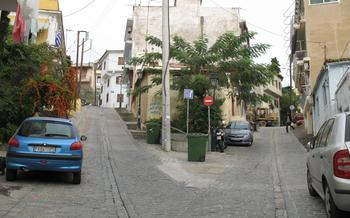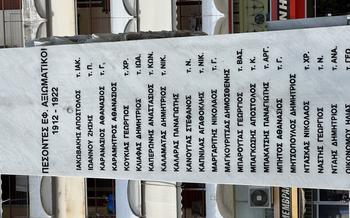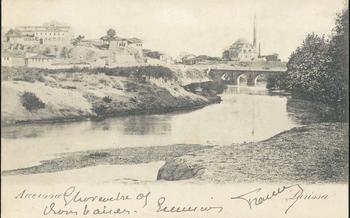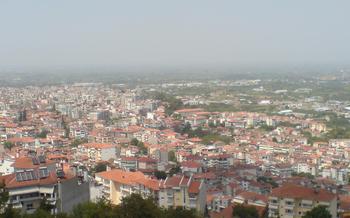
The Church of Agia Sophia
- The Church of Agia Sophia: A Timeless Masterpiece
- A Journey Through Time: The Evolution of Agia Sophia
- Unveiling the Architectural Marvels of Agia Sophia
- Exploring the Sacred Interiors of Agia Sophia
- A Glimpse into the Lives of the Faithful
- The Church as a Symbol of Cultural Heritage
- Tracing the Footsteps of History at Agia Sophia
- The Church's Role in the Community
- The Church's Contribution to Art and Architecture
- Preserving Agia Sophia for Future Generations
- Tips for Visiting Agia Sophia: A Traveler's Guide
- Unforgettable Experiences at Agia Sophia
- Capture the Essence of Agia Sophia Through Photography
The Church of Agia Sophia: A Timeless Masterpiece
In the heart of Xanthi, Greece, stands the majestic Church of Agia Sophia, a testament to the enduring beauty and significance of Byzantine architecture. This sacred edifice, built in the 9th century, has stood as a beacon of faith and spirituality for generations, captivating visitors with its architectural grandeur, religious symbolism, and timeless aura.
Agia Sophia, dedicated to the Holy Wisdom of God, holds a profound place in the religious and cultural heritage of Xanthi. As one of the oldest and most well-preserved Byzantine churches in the region, it embodies the essence of Eastern Orthodox Christianity and serves as a symbol of the deep-rooted faith of the local community. The church's enduring legacy and architectural masterpiece make it a must-visit destination for pilgrims, history enthusiasts, and travelers seeking spiritual enlightenment.
A Journey Through Time: The Evolution of Agia Sophia
The Church of Agia Sophia has stood as a testament to the passage of time, witnessing the rise and fall of civilizations, and undergoing transformations that reflect the evolving religious and cultural landscape of Greece. Its origins can be traced back to the Byzantine era, when it was first constructed as a modest chapel dedicated to the Holy Wisdom. Over the centuries, the church underwent several expansions and renovations, each leaving its unique mark on the architectural masterpiece we see today.
During the Ottoman period, the church was converted into a mosque, with the addition of minarets and other Islamic features. The minarets, which were once symbols of Islamic dominance, now stand as a reminder of the complex history of the region and the coexistence of different faiths.
In the 20th century, the church underwent a major restoration project, which aimed to restore it to its original Byzantine glory. Mosaics and frescoes that had been hidden under layers of plaster were uncovered, revealing the stunning artistry of the Byzantine masters.
Today, Agia Sophia stands as a testament to the resilience and adaptability of faith, and to the power of architecture to transcend time and cultures. It is a symbol of the rich cultural heritage of Greece and a reminder of the enduring spirit of its people.
Unveiling the Architectural Marvels of Agia Sophia
The Church of Agia Sophia stands as a testament to the architectural ingenuity of the Byzantine era. Its intricate design and stunning embellishments showcase the fusion of various artistic influences that shaped the region. Visitors are awestruck by the harmonious blend of Byzantine, Islamic, and Ottoman elements, each contributing to the church's unique character.
The church's exterior facade captivates with its intricate brickwork and decorative patterns. The interplay of light and shadow creates a mesmerizing effect, highlighting the skillful craftsmanship of the builders. The grand entrance, flanked by towering pillars, invites visitors into a realm of sacred beauty.
Stepping inside the church, one is immediately drawn to the awe-inspiring dome. Its vast expanse and intricate mosaics create an ethereal atmosphere, evoking a sense of transcendence. The dome's design is a marvel of engineering, demonstrating the architects' mastery of structural balance and aesthetics.
The interior of Agia Sophia is adorned with exquisite mosaics and frescoes that depict biblical scenes, saints, and historical figures. These vibrant artworks bring the stories of faith and devotion to life, adding depth and richness to the church's spiritual ambiance.
The elaborate altars and ornate furnishings further enhance the church's visual splendor. The intricate carvings, precious metals, and shimmering gemstones create a sense of opulence and reverence. These elements work in harmony to create a sacred space that invites contemplation and spiritual reflection.
Exploring the Sacred Interiors of Agia Sophia
Step inside the doors of Agia Sophia, and you will be enveloped in an atmosphere of awe and reverence. The church's interiors are a testament to the rich spiritual heritage of the Greek Orthodox Church, adorned with stunning iconography, intricate frescoes, and elaborate altars.
The church's walls are adorned with stunning mosaics and frescoes that depict scenes from the Bible and the lives of saints. These intricate artworks are a visual feast, showcasing the exceptional skill and artistry of Byzantine craftsmen. The vibrant colors and lifelike depictions transport visitors to another time and place, allowing them to connect with the sacred stories and traditions of the Orthodox faith.
The iconography within Agia Sophia holds deep religious and symbolic meaning. Each icon is carefully chosen and positioned to convey a specific message or narrative. Visitors can spend hours admiring the intricate details and symbolism of these sacred images, gaining a deeper understanding of the Orthodox faith and its rich history.
The elaborate altars and ornate furnishings of Agia Sophia further enhance the church's sacred ambiance. The main altar, known as the Holy Table, is the focal point of the church, where the Eucharist is celebrated. It is adorned with intricate carvings, precious metals, and colorful textiles, symbolizing the divine presence and the importance of the sacrament.
Agia Sophia is not merely a historical monument but a living, breathing space where the faithful gather for prayer, worship, and spiritual nourishment. The church's sacred interiors create a unique and powerful atmosphere that invites visitors to connect with their own spirituality and experience the profound beauty and richness of the Orthodox faith.
A Glimpse into the Lives of the Faithful
The Church of Agia Sophia is not just a historical monument; it is a living, breathing testament to the power of faith. For centuries, the church has been a spiritual home to countless believers, who have found solace, guidance, and inspiration within its sacred walls.
The stories of devotion and religious traditions that surround Agia Sophia are as diverse as the people who have worshipped there. From the humble prayers of everyday believers to the grand ceremonies officiated by patriarchs and bishops, the church has witnessed it all. Each story, each prayer, and each tear has left an invisible mark on the church's very essence, imbuing it with a palpable sense of spirituality.
For many, Agia Sophia is more than just a place of worship; it is a refuge, a sanctuary where they can escape the trials and tribulations of everyday life. Here, they can commune with God, seek guidance from the saints, and find comfort in the knowledge that they are part of a larger community of believers.
One particularly poignant story is that of a young woman named Maria. She had been struggling with a debilitating illness for months, and her family had all but given up hope. One day, she was brought to Agia Sophia in a wheelchair, barely able to speak or move. As the priest blessed her with holy water and prayed for her healing, Maria felt a surge of warmth and energy coursing through her body. To everyone's amazement, she stood up from her wheelchair and walked out of the church on her own, completely healed.
Such stories are not uncommon at Agia Sophia. The church has been the site of numerous miracles and divine interventions, further solidifying its reputation as a sacred place of healing and hope. The faithful come from far and wide to seek blessings, pray for loved ones, and offer their heartfelt gratitude for the graces they have received.
Agia Sophia is not just a building; it is a living testament to the power of faith and the enduring spirit of the Greek Orthodox Church. Through the stories and experiences of the faithful, the church continues to inspire and uplift generations, serving as a beacon of hope and a reminder of the divine presence that surrounds us all.
The Church as a Symbol of Cultural Heritage
The Church of Agia Sophia stands as a resplendent embodiment of Greek Orthodox identity, its very essence entwined with the cultural heritage of the nation. It represents a tangible link to the past, a testament to the enduring faith and traditions of the Greek people. This revered edifice has become a symbol of national pride, a beacon of spiritual and cultural heritage that evokes a deep sense of reverence and belonging among the Greek faithful.
Agia Sophia's inclusion in various cultural preservation initiatives underscores its significance as a treasure to be cherished and safeguarded for posterity. The Greek government, in collaboration with international organizations, has undertaken extensive efforts to protect and restore this architectural marvel, ensuring its preservation for future generations. Through these endeavors, the church's cultural heritage is not only preserved but also shared with the world, fostering a greater understanding and appreciation of Greece's rich cultural tapestry.
Furthermore, Agia Sophia serves as a catalyst for promoting cultural heritage through tourism. Its inclusion in guided tours and cultural itineraries attracts visitors from around the globe, who come to marvel at its architectural splendor and immerse themselves in its spiritual significance. Through tourism, the church becomes a platform for cultural exchange, fostering dialogue and understanding between people of diverse backgrounds. By showcasing the beauty and history of Agia Sophia, Greece not only preserves its cultural heritage but also shares it with the world, contributing to a greater appreciation of the nation's cultural wealth.
Tracing the Footsteps of History at Agia Sophia
The Church of Agia Sophia has stood as a silent witness to some of the most pivotal moments in Greek history. Its walls hold the echoes of countless prayers, celebrations, and tribulations that have unfolded within its sacred space. Over the centuries, the church has borne witness to the ebb and flow of empires, the rise and fall of civilizations, and the indomitable spirit of the Greek people.
Throughout its existence, Agia Sophia has been a place of refuge, solace, and inspiration. During times of war and turmoil, the church offered its sanctuary to those seeking shelter and divine protection. Its bells have tolled to mark both joyous occasions and moments of profound sorrow. The church has played a crucial role in shaping the cultural and spiritual identity of Xanthi, becoming an integral part of the city's historical tapestry.
Within its hallowed halls, visitors can still sense the weight of history that lingers in the air. The worn steps, the faded frescoes, and the intricate carvings all tell a story of resilience, faith, and devotion. Each stone and tile bears witness to the passage of time, reminding us of the countless souls who have sought solace and guidance within these walls.
One of the most poignant stories associated with Agia Sophia is its survival during the Ottoman occupation. Despite being converted into a mosque, the church miraculously retained its Christian identity. The faithful continued to worship in secret, preserving their traditions and beliefs amidst adversity. This act of defiance and resilience is a testament to the enduring spirit of the Greek Orthodox faith.
Today, Agia Sophia stands as a living testament to the power of faith and the resilience of the human spirit. As visitors walk through its ancient doors, they are transported back in time, reliving the triumphs and tribulations that have shaped this sacred space. The church's history is a reminder that even in the face of adversity, the light of faith can never be extinguished.
The Church's Role in the Community
Agia Sophia, a beacon of spirituality and cultural heritage, plays a pivotal role in the community of Xanthi. Beyond its religious significance, the church serves as a hub for social gatherings, fostering a sense of unity and belonging among the local residents. Throughout the year, Agia Sophia hosts various community events, bringing people together to celebrate traditions, share experiences, and strengthen their bonds.
The church is also deeply involved in charitable and philanthropic activities, extending its support to those in need. Through food banks, clothing drives, and other initiatives, Agia Sophia actively contributes to the well-being and welfare of the community. It collaborates with local organizations to provide assistance to the underprivileged, demonstrating its commitment to social justice and compassion.
Furthermore, the church recognizes the importance of education and community development. It operates a Sunday school program, offering religious education and moral guidance to young members of the congregation. Agia Sophia also hosts workshops, seminars, and educational programs on topics related to history, culture, and spirituality, aiming to enrich the minds and hearts of the community members.
By embracing its role as a community center, Agia Sophia transcends its religious function and becomes an integral part of the social fabric of Xanthi. It fosters a sense of unity, promotes social welfare, and contributes to the overall growth and development of the community.
The Church's Contribution to Art and Architecture
The Church of Agia Sophia has played a pivotal role in shaping the trajectory of Byzantine and Orthodox art and architecture. Its groundbreaking design and exquisite ornamentation have served as a source of inspiration for countless artists and architects throughout history. The church's unique blend of architectural elements, such as the massive dome, intricate mosaics, and elegant frescoes, has left an indelible mark on the development of Eastern Christian art.
Agia Sophia's influence extends beyond its immediate surroundings, reaching far and wide to inspire architectural styles and motifs across the globe. Its innovative use of pendentives to support the dome and its incorporation of light and color have been replicated in numerous religious and secular structures around the world. The church's iconic status has made it a benchmark for architectural excellence, attracting scholars, artists, and architects from all corners of the globe to study and appreciate its timeless beauty.
Moreover, Agia Sophia's legacy in the realm of art and architecture is not merely confined to its physical structure. The church's rich iconography and symbolism have deeply influenced the development of religious art. Its stunning mosaics, depicting scenes from the Bible and the lives of saints, have become a hallmark of Byzantine art, serving as a visual representation of the church's teachings and beliefs.
Agia Sophia stands as a testament to the enduring power of art and architecture to transcend time and boundaries. Its influence on the artistic and architectural landscape of the world is undeniable, and its legacy continues to inspire and captivate generations of admirers.
Preserving Agia Sophia for Future Generations
The passage of time and the relentless forces of nature pose significant challenges to the preservation of Agia Sophia. As a testament to its enduring legacy, extensive conservation and restoration efforts have been undertaken to safeguard this architectural masterpiece for future generations. These endeavors require meticulous attention to detail, employing specialized techniques and materials to maintain its authenticity and structural integrity.
Preserving Agia Sophia's historic fabric involves addressing various forms of deterioration, including weathering, erosion, and seismic activity. Experts carefully assess the condition of the building, identifying areas that require immediate intervention. Through the use of traditional methods and modern technologies, they reinforce weakened structures, repair damaged mosaics and frescoes, and restore the church's vibrant colors.
One of the critical challenges in preserving Agia Sophia lies in balancing the need for conservation with the desire to maintain its original character. Restorers strive to retain the patina of age, ensuring that interventions do not compromise the church's historical integrity. This delicate balance requires a deep understanding of the building's materials, construction techniques, and artistic significance.
Furthermore, ensuring the church's accessibility and enjoyment for visitors is paramount. Accessibility modifications, such as ramps and elevators, are carefully integrated into the design to accommodate individuals with disabilities. By preserving Agia Sophia's architectural heritage while making it accessible to all, we create an inclusive environment that encourages appreciation and understanding of this sacred space.
Tips for Visiting Agia Sophia: A Traveler's Guide
Visiting the Church of Agia Sophia is a spiritually enriching experience that offers a glimpse into the depths of Greek Orthodox culture and history. To make the most of your visit, here are some practical tips and guidelines:
-
Visiting Hours: The church is generally open to visitors from 8:00 AM to 1:00 PM and 5:00 PM to 8:00 PM daily. However, it's advisable to check the official website or local sources for any changes in operating hours.
-
Admission Fees: Admission to the church is free of charge, allowing everyone to experience its beauty and significance without financial barriers.
-
Dress Code: As a place of worship, visitors are expected to dress modestly and respectfully. Shorts, tank tops, and revealing clothing are discouraged.
-
Behavior Guidelines: Maintaining silence and avoiding disruptive behavior is essential to preserve the sacred atmosphere of the church. Taking photographs is permitted, but using flash photography is prohibited.
-
Accessibility: The church is wheelchair accessible, ensuring that all visitors can enjoy its splendor. If you have any specific accessibility requirements, it's recommended to contact the church authorities in advance.
-
Best Time to Visit: To avoid crowds and capture the church's essence, it's advisable to visit early in the morning or late in the afternoon. The golden hues of sunrise and sunset cast a magical glow on the church's exterior.
Unforgettable Experiences at Agia Sophia
A visit to Agia Sophia is not just a historical or architectural exploration; it is a journey of the soul. Over the centuries, countless souls have found solace, inspiration, and spiritual transformation within its sacred walls. Their stories, like whispered prayers, echo through the centuries, creating an aura of reverence and awe.
One such story is that of a young woman named Eleni, who had long yearned to visit Agia Sophia. When she finally stood beneath its majestic dome, tears of joy streamed down her face. The sheer beauty and grandeur of the church overwhelmed her senses, and she felt a profound connection to the divine.
In another instance, a weary traveler named Dimitrios sought refuge within the church during a stormy night. As he knelt in prayer, he felt a sense of peace and tranquility wash over him. The worries that had burdened his heart seemed to dissipate, replaced by a newfound sense of hope and resilience.
These are just a few glimpses into the countless stories of transformation and enlightenment that have unfolded within Agia Sophia. Each visitor carries their own unique experiences and emotions, adding to the rich tapestry of the church's history. It is a place where the past and present intertwine, where faith and devotion find a home, and where the human spirit soars towards the heavens.
Capture the Essence of Agia Sophia Through Photography
The Church of Agia Sophia is a visual masterpiece that demands to be captured in photographs. With its intricate mosaics, stunning frescoes, and awe-inspiring architecture, it's no wonder that many visitors bring their cameras to document their visit. To truly capture the essence of this sacred space, here are a few photography tips:
Embrace Natural Light: Agia Sophia's interior is illuminated by natural light, which changes throughout the day. Plan your visit during the golden hours of sunrise or sunset to take advantage of the soft, warm light that enhances the church's colors and textures.
Find Unique Perspectives: Step away from the crowds and explore different angles to find unique perspectives that showcase the church's grandeur. Experiment with wide-angle shots to capture the vastness of the interior or zoom in on intricate details for a more intimate feel.
Respect the Sanctity: Remember that Agia Sophia is a place of worship, so be respectful of the ongoing services and activities. Avoid using flash photography or making excessive noise, and always ask permission before taking photos of people.
Discover Hidden Gems: Look for hidden corners and details that often go unnoticed. The church's exterior offers stunning views, so don't forget to capture the intricate carvings and architectural elements that adorn the facade.
By following these tips and embracing the spirit of exploration, you'll be able to capture the beauty and essence of Agia Sophia through your lens, creating lasting memories of your visit to this awe-inspiring monument.






